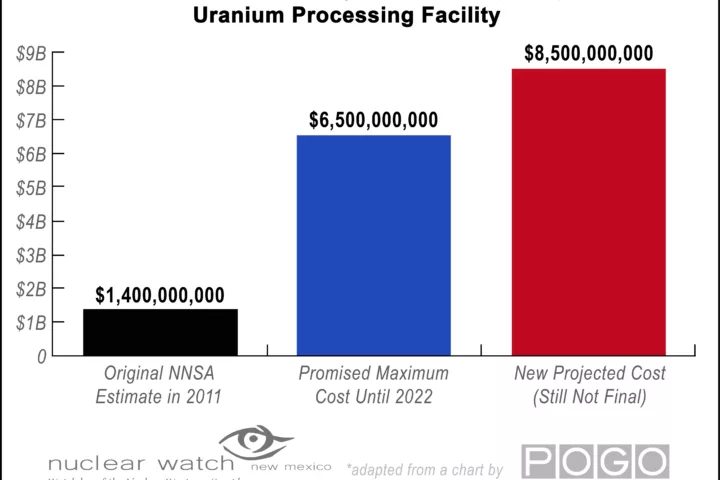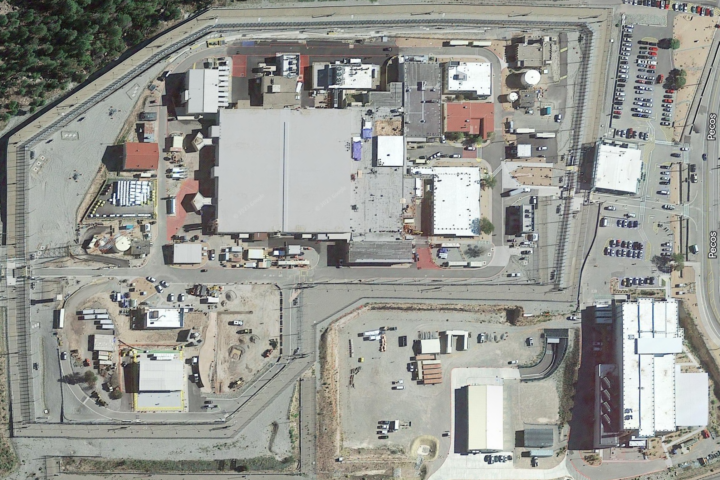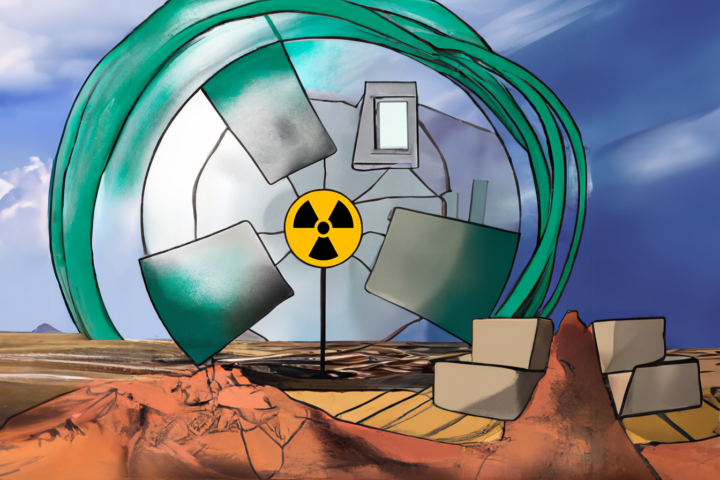Over the last decade funding for the Los Alamos National Laboratory’s (LANL’s) nuclear weapons programs has increased 20%. However, funding for needed cleanup has remained flat at one-tenth of the almost $2 billion requested for nuclear weapons programs in FY 2020. Nuclear weapons funding is slated to keep climbing under the $1.7 trillion 30-year nuclear weapons “modernization” program begun under Obama. Trump is adding yet more money, and is accelerating the new arms race with Russia by adding two new types of nuclear weapons. Cleanup funding, on the other hand, is doomed to stay flat for the next two decades because the New Mexico Environment Department (NMED) under Gov. Martinez gutted a 2005 “Consent Order” that would have forced the Department of Energy (DOE) and LANL to get more money for cleanup.
Seventy-five years of nuclear weapons research and production have left the land and groundwater under LANL contaminated with many hundreds of types of radioactive and hazardous wastes. As late as 1996, the Lab was publicly claiming that groundwater contamination was impossible, even requesting a waiver from NMED from having to monitor at all. That was fortunately rejected, given what we now know is extensive groundwater contamination by high explosives, perchlorates and hexavalent chromium (the carcinogen made famous by the movie Erin Brockovich) threatening water supply wells in Los Alamos County.
Background: In 2005, NMED forced the Energy Department to agree to a Consent Order that finally addressed Lab contamination – – its underlying intent was to make DOE get more funding for cleanup. After Gov. Martinez took office in 2011, NMED reversed itself and eviscerated the Consent Order by granting more than 150 milestone time extensions at LANL’s request. NMED Secretary Ryan Flynn then had the gall to claim the Consent Order wasn’t working.
That was the political cover for NMED heavily revising the Consent Order in June 2016, creating loopholes where DOE and LANL could avoid cleanup by simply claiming that it is too difficult or costly. Nuclear Watch had sued DOE and LANL for missing cleanup deadlines under the original Consent Order, which had the potential to levy up to $300 million in penalties that would have gone to New Mexico while it was in a budget crisis. Instead, NMED intervened in the case againstthe environmentalists, and completely forgave LANL’s potential penalties.
The revolving door:Not long after the revised Consent Order went into effect, NMED Secretary Ryan Flynn resigned to become the Executive Director of the New Mexico Oil and Gas Association, whose main mission is to lobby against environmental regulations. The Environment Department’s chief negotiator for the revised Consent Order, Kathryn Roberts (then-NMED Director of the Resource Protection Division and a former LANL employee), left to work for Longenecker and Associates, a DOE contractor. At Longenecker, Roberts joined Christine Gelles, who, as the former head of DOE environmental management programs at LANL, initiated negotiations with NMED and Roberts over the revised Consent Order. Longenecker is now a subcontractor on the new LANL cleanup contract.
Future cleanup at LANL:Not coincidentally, three months after the revised Consent Order went into effect, DOE released estimated baseline costs for LANL cleanup, with a top range of $4.1 billion to complete cleanup around 2036. This has doomed Lab cleanup funding to $200 million or under per year, when NMED has been on record that around $250 million annually is needed.
In its baseline cost estimate DOE also claimed that only 5,000 cubic meters of mixed radioactive and toxic wastes need to be exhumed and treated. This willfully ignores the estimated ~150,000 cubic meters of radioactive and hazardous wastes buried in unlined pits and trenches in LANL’s largest waste dump (Area G) alone. DOE plans to “cap and cover” and leave those wastes buried forever, creating a permanent nuclear waste dump above our groundwater, three miles uphill from the Rio Grande. Alarmingly, plutonium has already been detected 200 feet below Area G’s surface, almost a quarter of the way to the Española Basin groundwater aquifer, the sole source water supply for nearly 200,000 people.
Chromium groundwater contamination: In July 2017 LANL detected far more hexavalent chromium (Cr) groundwater contamination than previously estimated in the “sole source” regional groundwater aquifer that serves Los Alamos, Santa Fe, and the Española Basin. Sampling from a new well, originally designed to inject treated groundwater back into the aquifer, detected chromium contamination five times greater than the New Mexico groundwater standard of 50 micrograms per liter. More current data from a newer regional monitoring well indicate that the leading edge of the plume is now a quarter- mile from a drinking water production well for Los Alamos County, with and chromium contamination deeper than previously thought. The plume may be moving farther east toward San Ildefonso Pueblo and the Buckman Wells, which the City of Santa Fe relies on for a third of its drinking water. In an effort to bioremediate the chromium into a harmless form, the Lab experimented with pumping molasses into the aquifer. Not surprisingly that has plugged filters and clogged at least one expensive monitoring well, illustrating the need for well thought out solutions.
The future of LANL cleanup is in the new administration’s hands. We now have a new Governor and new leadership at the New Mexico Environment Department. We look forward to NMED actually regulating cleanup at LANL, which the Martinez Administration failed to do. We oppose planned “cap-and-cover” of LANL’s radioactive and toxic wastes that will create permanent nuclear waste dumps. We need a fire lit under DOE to pick up the pace of genuine cleanup at the Lab. We need to solve the water contamination problems quickly instead of planning to pump and treat virtually forever.
Conclusion: Governor Michelle Lujan Grisham should direct NMED to renegotiate the 2016 Consent Order and compel DOE to enter into a new legal agreement that has the best interests of New Mexico at heart. That would be a real win-win for northern New Mexicans, permanently protecting the environment and our precious water resources while also creating hundreds of high-paying jobs.



